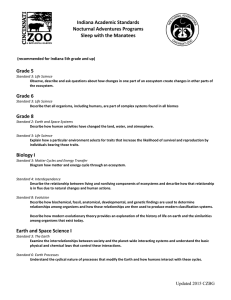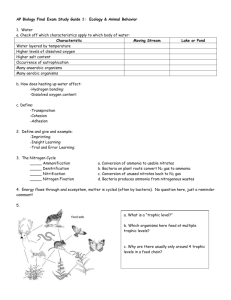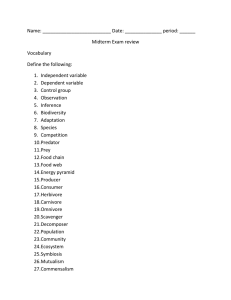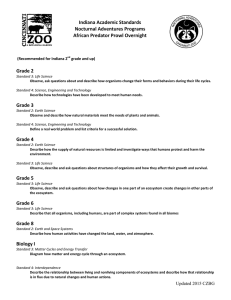Ecology Notes
advertisement
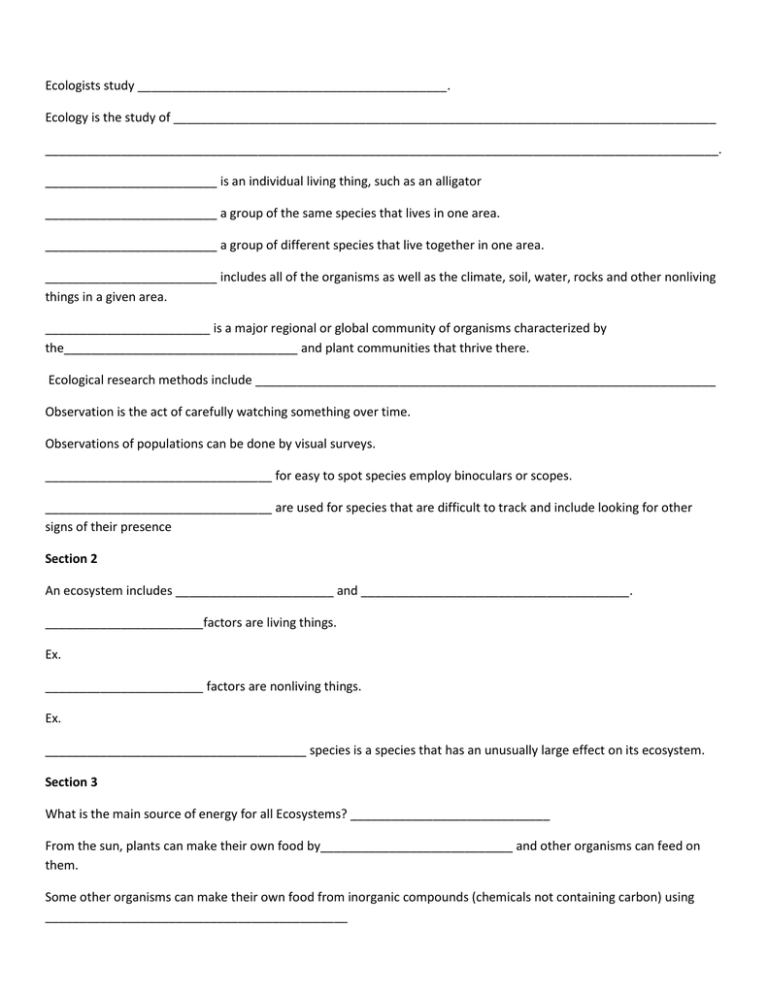
Ecologists study _____________________________________________. Ecology is the study of _______________________________________________________________________________ __________________________________________________________________________________________________. _________________________ is an individual living thing, such as an alligator _________________________ a group of the same species that lives in one area. _________________________ a group of different species that live together in one area. _________________________ includes all of the organisms as well as the climate, soil, water, rocks and other nonliving things in a given area. ________________________ is a major regional or global community of organisms characterized by the__________________________________ and plant communities that thrive there. Ecological research methods include ___________________________________________________________________ Observation is the act of carefully watching something over time. Observations of populations can be done by visual surveys. _________________________________ for easy to spot species employ binoculars or scopes. _________________________________ are used for species that are difficult to track and include looking for other signs of their presence Section 2 An ecosystem includes _______________________ and _______________________________________. _______________________factors are living things. Ex. _______________________ factors are nonliving things. Ex. ______________________________________ species is a species that has an unusually large effect on its ecosystem. Section 3 What is the main source of energy for all Ecosystems? _____________________________ From the sun, plants can make their own food by____________________________ and other organisms can feed on them. Some other organisms can make their own food from inorganic compounds (chemicals not containing carbon) using ____________________________________________ ___________________________________________provide energy for other organisms in an ecosystem. Producers get their energy from ____________________________ resources. Producers are also called ___________________________________ because they make their own food. Types of Autotrophs ____________________________________- capture energy from sunlight and convert it to carbohydrates Ex. ____________________________________- capture energy from heat and inorganic compounds and convert it to carbohydrates Ex. Some bacteria in extreme environments capture energy from inorganic compounds by___________________________ Section 4 A ________________________________ is a model that shows a sequence of ________________________________. A food chain links species by their _______________________________________. It follows the connection between one producer and a _______________________of consumers within an ecosystem. ______________________________________ are consumers that primarily eat one specific organism or a very small number of organisms. __________________________________________are consumers that have a varying diet _______________________________________________Organisms that eat OR absorb food to obtain energy _________________________ Eat only plant life ex. _________________________________Feed on other consumers Ex. Omnivores- ________________________________________________________________________________________ Ex. Detritivores and Scavengers: __________________________________________________________________________ Ex. _______________________________________Break down organic matter and return it to the earth as inorganic matter Ex: Detritivore vs. Decomposer __________________________________________________________ are the nourishment levels in a food chain. _________________________________________ are herbivores that eat producers. _________________________________________ are carnivores that eat herbivores. __________________________________________ are carnivores that eat secondary consumers. _________________________________________, such as humans that eat both plants and animals, may be listed at different trophic levels in different food chains. ___________________________________________________ shows a complex network of feeding relationships. A food web emphasizes complicated feeding relationships and energy flow in an ecosystem. Purpose of food webs and chains: Show how___________________________________ flows in an ecosystem Direction of the arrow is the direction of ________________________________________- do NOT mix this up! Energy Flows in one direction through an ecosystem: Along the way, some energy is _____________________________ (thermal energy) Law of Conservation of Energy: energy cannot be created or destroyed, __________________________________ from one form to another Light energy is converted to chemical energy stored in food (during photosynthesis). The plant USES some of it to grow, to reproduce, to help make food, etc. Energy is released as_____________________________________ Hence through a food chain, much of the energy is lost to the environment as heat. Section 5 Biogeochemical Cycles Biogeochemical Cycles While energy is transferred in one direction in an ecosystem, _____________________ is cycled through the ecosystem in the biogeochemical cycles Biogeochemical Cycles __________________________ how water moves through the air, land, and organisms _______________________________- water to vapor from surface of bodies of water _______________________________- water to vapor from plants _______________________________- vapor to water in clouds _______________________________- clouds become too full and rain, snow, etc. fall to the earth ________________________________- water collects into bodies of water ________________________________- water from the surface sinks into ground water storage _________________________is the building block of life. The carbon cycle moves carbon from the atmosphere, through the food web, and back to the atmosphere. Carbon is emitted during the burning of ____________________________. Some carbon is stored for long periods of time in areas called __________________________. The _______________________________ mostly takes place underground. Some bacteria convert gaseous nitrogen into ammonia through a process called ______________________________________. Some nitrogen-fixing bacteria live in nodules on the roots of plants; others live freely in soil. ______________________________ released into the soil is transformed into ammonium. Nitrifying bacteria change the ammonium into nitrate. Nitrogen moves through the food web and returns to the soil during decomposition. ____________________________________- bacteria take nitrogen (N2) from the atmosphere and change it into a form that plants can take up from the soil called ammonium (NH4). ______________________________- ammonium not taken up by plants are converted to nitrates and nitrites by bacteria which other plants can take up _______________________________- bacteria can turn the ammonium back to atmospheric nitrogen ______________________________ takes place at and below ground level. _______________________ is released by the weathering of rocks. Phosphorus moves through the food web and returns to the soil during ____________________. Phosphorus leaches into groundwater from the soil and is locked in sediments. Both mining and agriculture add phosphorus into the environment Nutrient Limitations An ecosystem needs a particular amount of each nutrient to thrive. A single nutrient can limit its success. An excess of a particular nutrient can cause over production of algae and plant growth Human Effects on Biogeochemical Cycles ________________________________ overgrowth of photosynthetic organisms in a body of water due to an excess of nitrates and phoshates from urban or agricultural runoff Section 6 Ecological Pyramids ______________________________________________ shows the distribution of energy among trophic levels. Energy pyramids compare energy used by producers and other organisms on trophic levels. Between each tier of an energy pyramid, up to _________________ of the energy is lost into the atmosphere as_____________. Only ____________________ of the energy at each tier is transferred from one trophic level to the next. ___________________________________ is a measure of the total dry mass of organisms in a given area. A pyramid of numbers shows the numbers of individual organisms at each trophic level in an ecosystem.
